Understand the difference between native ads, sponsored content, display ads and remarketing ads
The world of digital advertising is evolving faster than ever before and it can even be challenging for marketing executives to keep up with correct terminology.
One advertising term which is frequently still misunderstood and misused is native advertising.
Copy Blogger ran a survey to establish how familiar businesses were with native advertising. The results revealed there was a great deal of uncertainty and a lack of confidence with the advertising technique:
49% of respondents didn’t know what native advertising was 24% were hardly familiar with it Another 24% were somewhat familiar Only 3% were very knowledgeable
This means businesses are failing to utilise native advertising, due to lack of knowledge. For end users, it can be hard to distinguish native ads from news articles, sponsored content and Google ads, such as display advertising and remarketing ads.

This is understandable because, as most marketing professionals know, it is very difficult to recognise if what you are seeing on a website is a display ad, remarketing ad or native ad. Yet surprisingly, it is not just end users who seem to be confused. Many people within marketing agencies incorrectly use the terms native advertising and sponsored content synonymously.
It is necessary for marketers and businesses to correctly grasp the nuance between different marketing techniques to properly harness their power. Both native advertising and sponsored content are also now entering the publics’ awareness. In late 2015 South Park actually launched a whole episode covering the clever evolution of digital advertising, including sponsored content. Marketers cannot afford to be left behind by their own tech savvy audience and miss the opportunities native advertising and sponsored content present.
Native ads are ads that are designed to blend in with the content on a webpage. They are often placed in the middle of a feed of articles or in the middle of a long article. They are meant to be less obtrusive than traditional banner ads, and are often labelled as “sponsored content” or “promoted content.”
Sponsored content is a type of native ad that is created by an advertiser and placed on a website. It is meant to look and feel like the website’s regular content, and is often labeled as “sponsored” or “promoted.”
Display ads are ads that are displayed on websites and are typically banner ads or other types of graphical ads. They can be placed in various locations on a website and are often used to promote products or services.
Remarketing ads are ads that are shown to users who have previously visited a website. They are often used to try and entice users to come back to the website and make a purchase. These types of ads are typically display ads and are shown to users as they browse the internet after they have left the original website.
- Type of Ad – Description
- Native Ads – Ads that are designed to blend in with the content on a webpage and are often placed in the middle of a feed of articles or in the middle of a long article.
- Sponsored Content – A type of native ad that is created by an advertiser and placed on a website. It is meant to look and feel like the website’s regular content, and is often labeled as “sponsored” or “promoted.”
- Display Ads – Ads that are displayed on websites and are typically banner ads or other types of graphical ads. They can be placed in various locations on a website and are often used to promote products or services.
- Remarketing Ads – Ads that are shown to users who have previously visited a website. They are often used to try and entice users to come back to the website and make a purchase. These types of ads are typically display ads and are shown to users as they browse the internet after they have left the original website.
According to data collected by Contently, a large proportion of end users cannot tell the difference between a genuine news article and an ad.
For advertisers who are in the know and using native advertising and/or sponsored content effectively, this is very good news. For businesses whose native ad knowledge is lacking, now is the time to become educated and enjoy the benefits of these strategies.
Native ads and sponsored content are similar in many ways and they do overlap. It is therefore easy for the uninitiated to get the terms mixed up, so it is time to look at the specific definitions.
What are native ads
Native ads are any type of advert which has been designed to resemble the style of the publication it sits upon.
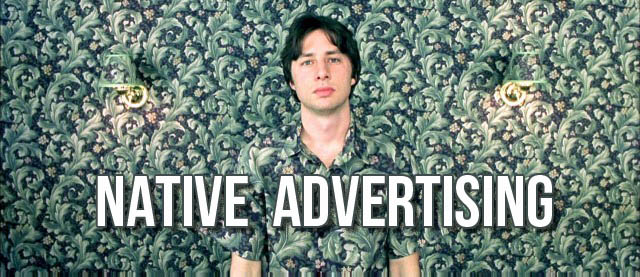
Native ads can be created as articles or similar to display ads or even videos. They can embody almost any variety of content style but as long as their goal is to blend seamlessly with the third-party website they are on, they can be considered a native ad.
The one element that makes native ads distinguishable from organic content or news is that by law they must state that they are an ad. Usually this labelling will be very subtle and easily missed.
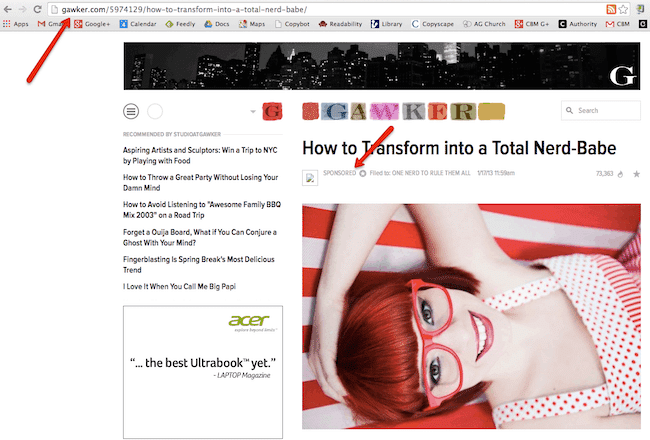 However, many advertisers are failing to properly label their native ads, which means there are theoretically ads floating around which cannot be distinguished from content or news.
However, many advertisers are failing to properly label their native ads, which means there are theoretically ads floating around which cannot be distinguished from content or news.
What is sponsored content.
Sponsored content is an article which an advertiser has paid to be placed on a third-party publication site.
Sponsored content is a type of native ad. In fact, the majority of examples you will see of native ads are sponsored content, as it is the most popular format.
Take a look at this highly amusing clip from the comedy show Last Week Tonight. It will walk you through the nature of native ads with some great examples and also explores some of the moral issues of native ads for publishers.
You will note that most of the examples are sponsored content i.e. article format native ads but in the first few seconds the video also shows how even the video itself could be a native ad with some hilarious heavy handed references to product placement:https://www.youtube.com/embed/XNh9IWQyDOs
While native ads would never be as obvious as the fake promotion of Mountain Dew in the video (as they would then fail at being subtle enough to qualify as a native ad) it is still a helpful introduction into native ads.
Core differences between sponsored content and native ads
Sponsored content is a type of native ad but not the only kind, hence the two are not synonyms. While sponsored content is always a native ad, a native ad does not have to be an article. By definition it can be any ad which blends into the environment of the hosting website, so native ads could even resemble display ads in their structure. They could be an image with a call to action, a video or a whole other multitude of media.
While sponsored content clearly fits within the encompassing definition of native advertising, in that it blends into its surroundings, we can make the additional distinction that sponsored content is a kind of content marketing, whereas other forms of native ads might be purely part of your PPC strategy.
The Content Marketing Institute point out that in addition to conflating sponsored content and native advertising, many marketing executives are using the terms sponsored content, native advertising and content marketing interchangeably and as they rightly point out this just isn’t true.
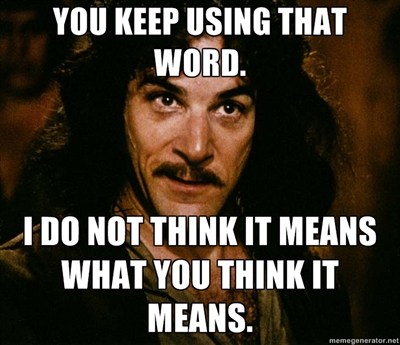
The confusion probably stems from the fact that sponsored content or any content designed to sell a service or product is a large part of content marketing. It is rare or arguably impossible to encounter content truly for content’s sake from a business.
There will always be a promotional agenda, even if it is just brand awareness or to encourage thought around a particular topic for your audience e.g. this sponsored content from Netflix on the New York Times on the subject of female prisoners in preparation for launch of the new series of Orange is the New Black:
Unlike other content marketing, sponsored content must be a paid slot hosted on another publication.
Content marketing involves the creation and distribution of valuable, entertaining and relevant content to attract your target audience.
Other forms of content marketing might take place on the advertiser’s own website or other channels. This would not be sponsored content.
The chart below from Contently clearly explains the relationship between native advertising, sponsored content and branded content (all other forms of content marketing)
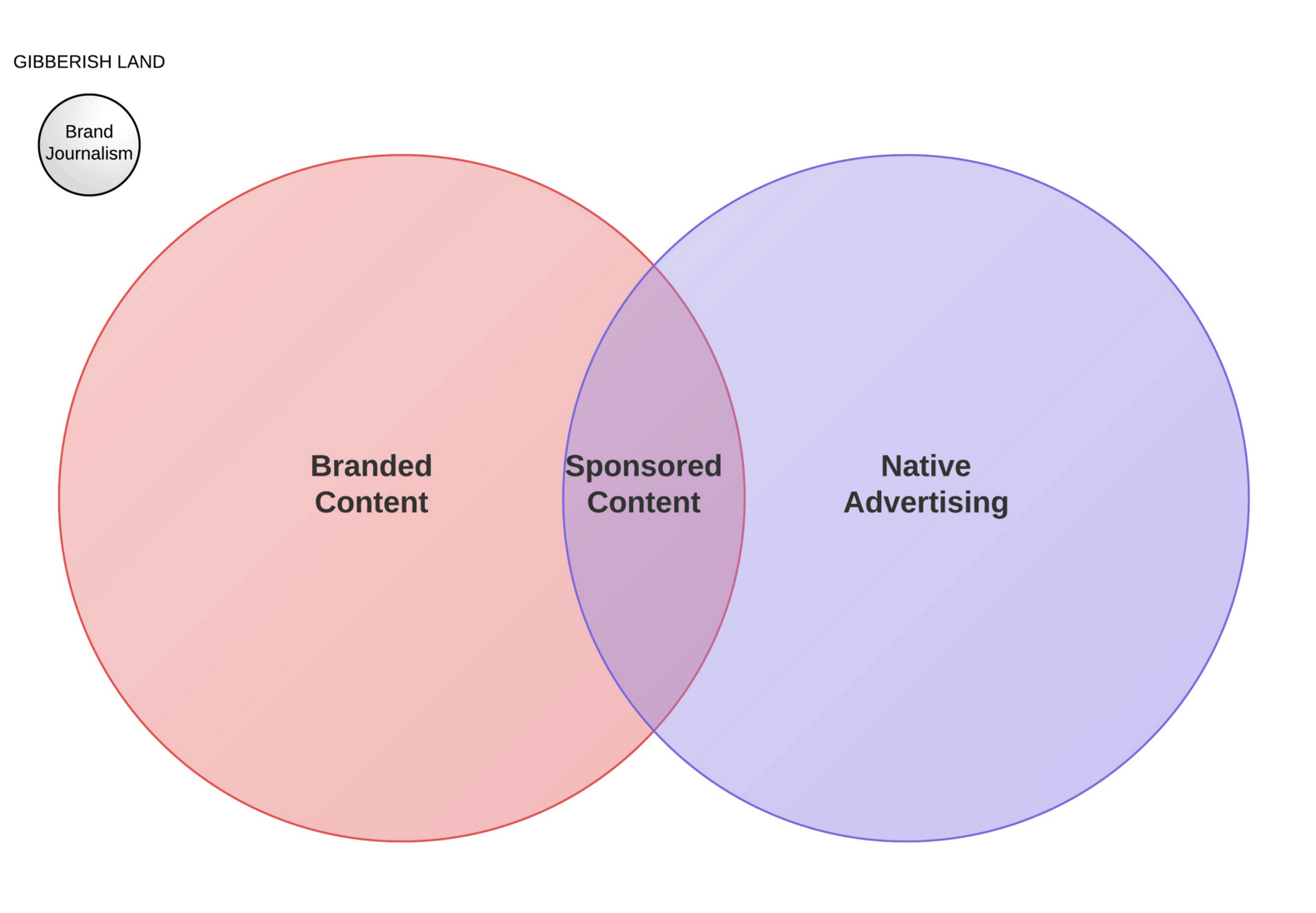 If marketers continue to use these terms incorrectly the further the misunderstanding will spread in the industry. Understanding the differences is important as it opens up executives to other forms of native ads that may aid their digital strategies. In digital marketing ignorance is not bliss.
If marketers continue to use these terms incorrectly the further the misunderstanding will spread in the industry. Understanding the differences is important as it opens up executives to other forms of native ads that may aid their digital strategies. In digital marketing ignorance is not bliss.
The different types of native ads
If you have previously confused native ads and sponsored content you may be wondering what other forms of native ads you can use. There are actually many different kinds of native ads and more are likely to be developed as the ads continue to evolve to keep pace with intelligent users, who have high demands from the content they absorb.
There are several main varieties of native ads that digital marketers frequently use:
Recommended content engine widgets – You will often see recommend content boxes after reading an article on various publications. These sometimes send you off to another site on the web or keep you onsite with a sponsored article. Taboola and Outbrain often use this format of native ad on third party sites to promote client brands. This is a good method to use for increasing traffic with native ads.
Promoted listing – These are completely different from article based native ads but they still aim to fit seamlessly into the users’ browsing experience. E-commerce websites, affiliate marketers and online marketplaces frequently use the promoted listing style native ad. This aids the promotion of sponsored products that are already listed on the site e.g. Amazon native ads. View the helpful example from Mequoda below.
In-feed units – These are the sponsored content promotions on publisher sites. They try to look like any other article.
Custom native ads – These are native ads that don’t fit one specific platform but can be used across multiple publishers. This may sound like a contradiction when we remember the definition of native ads as blending with their host site but Google’s Double Click specialises in exactly this type of native ad.
For native Google ads with Double Click they define custom native ads as those which have some customisable variables for the advertiser, that will not disrupt the native visual style of the ad.
Google is not the only search engine investing in native ads on their display network as Bing has followed suit with their own native ads for MSN currently in Beta in the USA.
In-ad with native elements – As the name implies in-ads with native elements are not pure native ads. They may not blend with the publisher site quite as well as other native ads but they do have some native qualities to give them an advantage. These native ads are very similar to display ads but are far more contextually relevant to the content on which they are displayed. This may sound reminiscent of programmatic display advertising, however position on publisher sites for in-ads with native elements may not necessarily be bought with programmatic software or a programmatic bidding system. The example below from Mequoda shows how similar these ads could look to a display ad.
Technically you could even include search ads, such as the Google ads shown at the top of search results, as native ads. They do conform to the definition of blending in with the other results in their environment, however in modern digital marketing when most people discuss native advertising they are referring to ads on third party publisher sites that blend with the rest of the content and are rarely referring to search ads.
Now you understand that, although sponsored content is a subspecies of native ads, the two terms mean quite different things, as sponsored content is merely one of main varieties of native ad formats.
As you can see native ads can go beyond just articles or well camouflaged display ads. They can be purely an image experience or articles or a sophisticated mixture of the two and even offer interactive experiences or rich media experiences. The misunderstanding between sponsored content and native ads likely persists because they are the most popular form of native ad. According to State of Advertising 65% of survey respondents voted sponsored blog posts as their favourite native ad format with 56% voting for sponsored Facebook updates.
Social media is a good example of advertisers using native ads without even realising. Since we call this social media marketing or paid social, advertisers often do not realise these are native ads. When you think about it makes perfect sense because these platforms have always tried to make their ads very similar to non-sponsored posts in appearance.
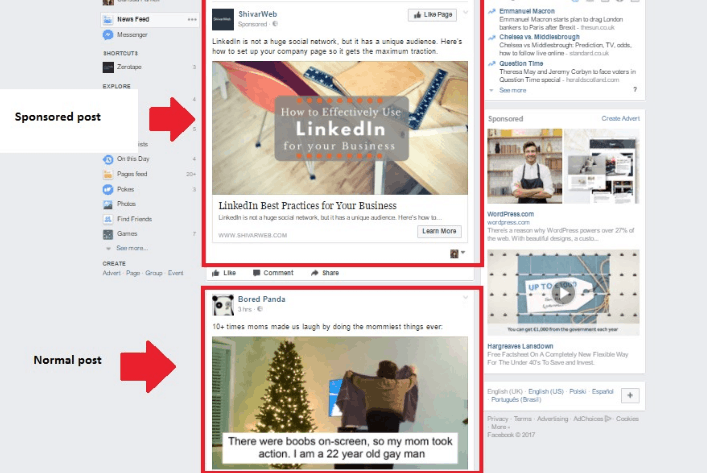
Native ads vs display ads and remarketing ads
Display ads are normally banner ads showing on third party sites on a CPC basis. Visual Google ads shown on the GDN are examples of display ads:
Remarketing ads for display look very similar to display ads:
The only way to guess the difference is if you have recently been to the website of the advertiser. Remarketing ads use cookies, so that when you visit a website the business can remarket to you later using display ads. The benefit for the advertiser is that you have already shown an interest in their site and so are more likely to buy. A display ad is potentially leading to a website you have never been to or heard of.
As you can see these ads stand out, they look like the banner ads we are accustomed to seeing and more importantly ignoring. Native ads of all formats are designed so that users do not have the instant awareness that the ad is out of place or an obvious assault on the content they are enjoying or an overt sales pitch. Native ads are supposed to be far more tailored and subtle.
Native ads have already proven to be leaps and bounds ahead of display ads when it comes to successful marketing. The infographic below from Sharethrough reveals just how much more effective native ads can be on your target audience.
This does not mean display ads are at their end. Display advertising is very efficient for advertisers as it takes less creative and technical talent and a display campaign can be quickly created within Google AdWords. No messing with Double Click contracts or publisher contracts required.
Should you embrace native ads?
If you are wondering if native advertising is worth the investment, it may interest you to know that Forbes record native ads delivering an increase in brand lift by up to 82%. Native ads with rich media have been shown to increase conversions by up to 60%.
Those are some compelling statistics for advertisers. It is not just advertisers who are falling in love with native ads either, Inc.com reports that 70% of internet users would rather learn about products through content, rather than traditional ads, which shows sponsored content could be used to great effect.
Make sure your native advertising campaigns are high quality
Now that you know the correct terminology you can make informed choices about which native advertising is right for you.
The most important features to bear in mind for successful native advertising are quality, helpfulness, relevance and context. Advertisers need to learn to be careful with both their sponsored content and native ads. The trick is to make the native ads so relevant, useful and not too sales orientated, that users do not know they are experiencing an ad.
When executed poorly, native ads fail because users can too easily see their true purpose and your potential customers don’t like to be tricked.

Easy to spot native ads can be as frustrating to users as display ads. In a perfect world, native ads are the next step in digital marketing intelligence and can create a better experience for users but some advertisers will ruin it for the rest of us. Sadly, some native ads and sponsored content have become more like spammy clickbait than useful knowledge. This can be frequently seen on the recommended content engine widgets on content curation websites.
